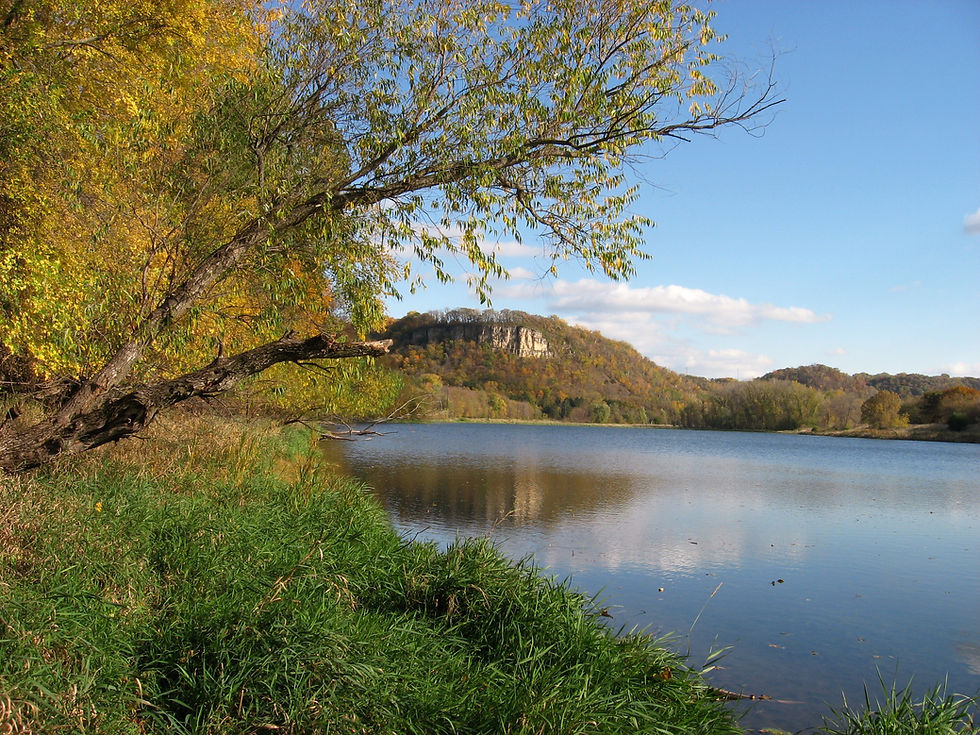Spring Is Busting Out All Over
- Bruce Ause
- Apr 26, 2017
- 3 min read

Leaves coming out on bluff behind Wacouta Bay
Since my last post, there has been a plethora of evidence that full blown spring is upon us. Willow trees along the river and several species on the bluff are leafing out displaying soft green foliage.

Dutchman's breeches
Several spring ephemerals like bloodroot, large-flowered bellwort and Dutchman's breeches are appearing en mass on the forest floor. These delicate spring wildflowers need to come forth and reproduce before the forest canopy robs them of necessary sunlight. The flowers of Dutchman's breeches featured in this photo have two inflated spurs suggesting the legs of tiny pantaloons with the ankles up.

Hen Wood Duck
An array of exciting and colorful birds are starting their annual nesting activities. On Friday April 21st, our backyard resident hen wood duck began incubating her full clutch of eggs. If all goes well, we can expect the tiny ducklings to hatch from these eggs in anywhere from 28 to 37 days. Hopefully in a future post, I could provide a photo of them jumping from the nest box.

Canada goose nest and eggs
While paddling my canoe on the bay on April 21st, I accidentally flushed a female goose off her nest of six large white eggs. She will do all the incubating while the gander will guard and protect the nest and surrounding area.

Goose on her nest
Generally speaking, Canada geese will have their nest on the ground or on top of a muskrat house. Unfortunately, they frequently lose these nests when water levels rise after the nests were established. This well camouflaged goose and nest is located on the lower section of a floating log. Hopefully, it will rise and fall with the changing water levels.

American White Pelicans
Living at the Head of Lake Pepin, we are fortunate to have the opportunity to observe the two largest birds found in Minnesota. Trumpeter swans and white pelicans both have 8 foot wing spans. During spring and fall, several flocks of pelicans will migrate through this area. Depending on river levels, they may stick around for several days or a couple weeks. On my canoe outing mentioned earlier, I observed two flocks of about twenty each.

Preening pelicans
Upon closer examination, I discovered some of the pelicans were preening themselves. In addition, you might notice an unusual projection or horn on the upper mandible near the tip of the bill. This is part of the adult spring breeding plumage. These birds will eventually continue their migration to nesting grounds in southwest Minnesota and eastern portions of North and South Dakota.

Eastern Towhee
Among the new arrivals in the bird community the past couple weeks were eastern towhees, northern flickers and brown thrashers. All three of these species can be observed scratching around in the leaves of the forest searching for seeds, fruits and insects. Their unusual call is a musical trill "drink your tea drink your tea."

Northern Flicker
On the other hand, northern flickers are most often observed in our lawns or open habitats. I recently hiked the open prairie on top of Rattlesnake Bluff a couple days after a prescribed burn. Large flocks of flickers were observed scouring the burned area in search of available insects. Ants rank at the top of the popularity chart as a favorite food.

Brown Thrasher
When Kathy and I visit our daughter Karla in North Carolina, by far the most common bird call we hear is that of the northern mockingbird. Brown thrashers are the closest birds in this area that have a similar rambling, halting warble. In fact, these calls are so unusual that last week we observed walkers on the Rattlesnake Bluff trail look up into our tall cottonwood tree trying to locate it's origin. At the beginning of the nesting season, the male brown thrasher will sing from the tallest tree to claim it's territory.




Comments